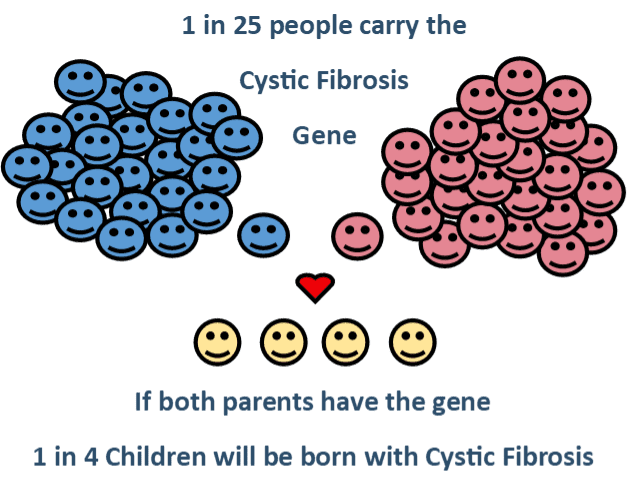What is Cystic Fibrosis?
Cystic Fibrosis (CF) is one of the most common life shortening chronic fatal genetic diseases affecting around 10,800 children and young adults in the UK. It affects the lungs and digestive system, making it difficult to breathe and digest food. Complications increase with age requiring ever increasing levels of care, treatment and support. The average life expectancy is in the late 30’s. There is no cure.
With your help we can give those living with Cystic Fibrosis a better life.
Cystic Fibrosis is an inherited condition in which the lungs and digestive system can become clogged with thick, sticky mucus.
It can cause problems with breathing and digestion from a young age. Over many years, the lungs become increasingly damaged and may eventually stop working properly.
Most cases of Cystic Fibrosis in the UK are now identified through screening tests carried out soon after birth. It’s estimated that 1 in every 2,500 babies born in the UK has Cystic Fibrosis.
A number of treatments are available to help reduce the problems caused by the condition, but unfortunately average life expectancy is reduced for people who have it.

Symptoms of Cystic Fibrosis
Symptoms of Cystic Fibrosis tend to start in early childhood, although they can sometimes develop very soon after birth, or may not be obvious until adulthood.
Some of the main symptoms of Cystic Fibrosis can include:
- recurring chest infections
- difficulty putting on weight
- frequent, wet-sounding coughs
- diarrhoea
- occasional wheezing and shortness of breath
People with the condition can also develop a number of related conditions, including diabetes thin, weakened of bones

We raise money to help people cope with Cystic Fibrosis
Causes of Cystic Fibrosis
Cystic Fibrosis is caused by a faulty gene that a child inherits from both of their parents.
The faulty gene means that some cells struggle to move salt and water across the cell wall. This, along with recurrent infections, can result in a build-up of thick, sticky mucus in the body’s tubes and passageways.
To be born with Cystic Fibrosis, a child has to inherit two copies of this faulty gene – one from each of their parents. Their parents will not usually have the condition themselves, because they will only carry one faulty gene and one that works normally.
If both parents carry the faulty gene, there’s a 25% chance that each child they have will be born with Cystic Fibrosis.

Screening and testing for Cystic Fibrosis
Most cases of Cystic Fibrosis are now detected soon after birth through the newborn blood spot test.
This involves collecting a drop of blood from the baby’s heel and testing it for abnormalities that could indicate Cystic Fibrosis.
More tests will be needed to confirm the diagnosis, such as:
- a sweat test – to measure the amount of salt in sweat, as the sweat of someone with Cystic Fibrosis has higher levels of salt than normal
- a genetic test – where a sample of blood or saliva is checked for the faulty gene that causes Cystic Fibrosis
These tests can also be carried out in older children and adults with symptoms of Cystic Fibrosis who haven’t been screened previously.
If you have a family history of Cystic Fibrosis, you can be tested to determine if you’re at risk of having a child with the condition by checking if you’re a “carrier” of the faulty gene that causes it.
Treatments for Cystic Fibrosis
There’s currently no cure for Cystic Fibrosis, but a number of treatments are available to help control the symptoms, prevent complications, and make the condition easier to live with.
Possible treatments include:
- antibiotics to prevent and treat chest infections
- medicines to make the mucus in the lungs thinner and easier to cough up
- medicines to widen the airways and reduce inflammation
- special techniques and devices to help clear mucus from the lungs
- medicines that help the person absorb food better
- following a special diet and taking supplements to prevent malnutrition
A lung transplant may eventually be needed if the lungs become greatly damaged.
Outlook for Cystic Fibrosis
Cystic Fibrosis is a progressive condition, which means it tends to get worse over time.
Eventually the condition can be fatal if it leads to a serious infection or the lungs stop working properly.
The outlook for Cystic Fibrosis has improved considerably in recent years because of advancements in treatment, although most people with cystic fibrosis will have a shorter-than-average life expectancy.
Currently, about half of the people with Cystic Fibrosis will live past the age of 40. Children born with the condition nowadays are likely to live longer than this.
Information
If you or your child has Cystic Fibrosis, your CF Specialist clinical team will discuss any problems you may have.
This site is strictly a news and information website about the disease. It does not provide medical advice, diagnosis or treatment. This content is not intended to be a substitute for professional medical advice, diagnosis, or treatment. Always seek the advice of your physician or other qualified health provider with any questions you may have regarding a medical condition. Never disregard professional medical advice or delay in seeking it because of something you have read on this website.
